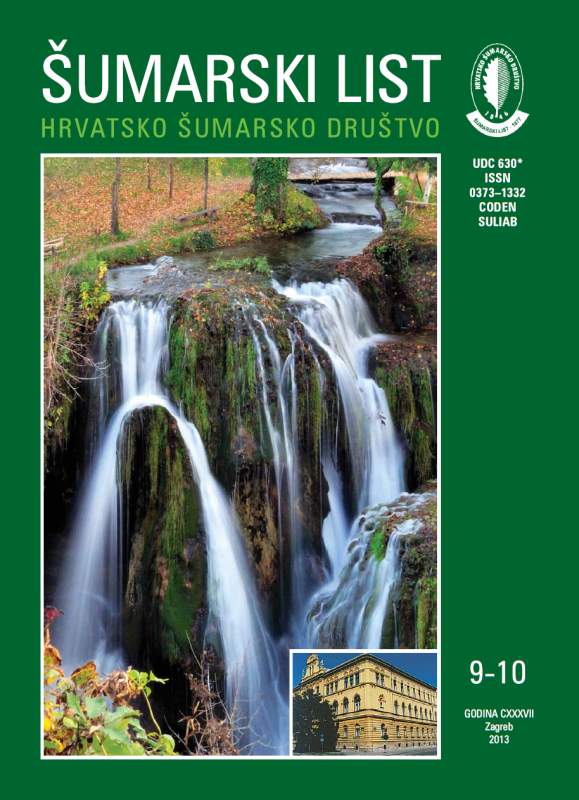
broj: 9-10/2013
pdf (8,91 MB) |
|
||||||||||||||
| RIJEČ UREDNIŠTVA | ||
| uredništvo | ||
| THE NEW EU FORESTRY STRATEGY: FOR FORESTS AND THE FOREST-BASED SECTOR pdf HR EN | 445 | |
| IZVORNI ZNANSTVENI ČLANCI | ||
| Damir DRVODELIĆ, Milan ORŠANIĆ, Sanja PERIĆ, Martina TIJARDOVIĆ | UDK 630*232.3+181.3 (001) | |
| INFLUENCE OF IRRIGATION AND MICRO-RELIEF IN NURSERIES ON MORPHOLOGICAL CHARACTERISTICS OF PEDUNCULATE (Quercus robur L.) AND SESSILE OAK (Quercus petraea L.) FOREST SEEDLINGS pdf HR EN | 447 | |
| Roman ROSAVEC, Zoran ŠIKIĆ, Željko ŠPANJOL, Damir BARČIĆ, Marko VUČETIĆ | UDK 630*431 (Pinus halpensis Mill) (001) | |
| WILDFIRE THREATS WITHIN THE HABITAT CONDITIONS IN ALEPPO PINE STANDS (Pinus halepensis Mill.) OF ADRIATIC KARST AREA pdf HR EN | 461 | |
| Jelena Nedeljković, Marko Lovrić, Dragan Nonić, Makedonka Stojanovska, Vaska Nedanovska, Nataša Lovrić, Vladimir Stojanovski | UDK 630*899 (001) | |
| INFLUENCE OF POLICY INSTRUMENTS ON NON-WOOD FOREST PRODUCTS COMMERCIALIZATION IN CROATIA, MACEDONIA AND SERBIA pdf HR EN | 473 | |
| Osman MUJEZINOVIĆ, Josip MARGALETIĆ, Tarik TREŠTIĆ, Mirza DAUTBAŠIĆ | UDK 630*451+151 (001) | |
| THE IMPACT OF THE HABITAT TO THE PRESENCE OF BANK MOLE (Myodes glareolus) AND YELLOW-THROAT MOUSE (Apodemus falvicollis) IN THE AREA OF BOSNIA pdf HR EN | 487 | |
| PRETHODNO PRIOPĆENJE | ||
| Milivoj FRANJEVIĆ | UDK 630*453 | |
| BIVOLTINISM OF EUROPEAN HARDWOOD AMBROSIA BEETLE Trypodendron domesticum IN CROATIAN LOWLAND OAK STANDS OF JASTREBARSKI LUGOVI pdf HR EN | 495 | |
| Boris Hrašovec, Darko Posarić, Ivan Lukić, Milan Pernek | UDK 630*453 | |
| FIRST RECORD OF OAK LACE BUG (Corythucha arcuata) IN CROATIA pdf HR EN | 499 | |
| Summary: The speed and volume ofrecently introduced alien and invasive species is reaching new dimensions recently. Largest group of these are insects, some of which are serious forest pests. Croatia has received its share of recent European introductions, the newest one being a second tingid species, oak lace bug Corythucha arcuata (Say, 1832). Sycamore lace bug, Corythucha ciliata (Say, 1832), has been the first one arriving to the Croatian soil soon after its introduction in northern Italy more than thirty years ago. Italy again, was the European country of first record for C. arcuata in 2000. Turkey and Switzerland followed soon, and in 2012 and 2013 its presence was confirmed in Bulgaria and Hungary. Summer yellowing of oak leaves in lowland stands of pedunculate oak (Quercus robur L.) and intensive chlorotic damages appearing on young oak plants in autumn urged for targeted research in the area of eastern Slavonia, Spačva basin. The abundant tingid species sampled in these forest stands proved to be the oak lace bug. Besides of the dominantly affected pedunculate oak leaves, damages and tingids developmental stages were also found on European crab apple (Malus sylvestris /L./), Rubus spp. and, for the first time, the field elm (Ulmus minor Mill) – Morphological identification based on relevant taxonomic keys can be eased for the practitioners with the description of slightly different coloring (dark brown blotches on semielytrae) of this lace bug versus already present and widely known sycamore lace bug. The first discovery of oak lace bug in Croatian territory in such a large area and at relatively high abundance puzzles since it has yet not been reported in neighboring countries (with the exception of Hungary where it was reported in a very small and localized population). It will be important to focus our attention on the very probable quick spread of the new oak pestin the near future and asses its potential negative impact on oak helath status in Croatian conditions. Key words: invasive species; alien species; Spačva; Slavonia; pedunculate oak; Quercus robur; field elm; Ulmus minor | ||


